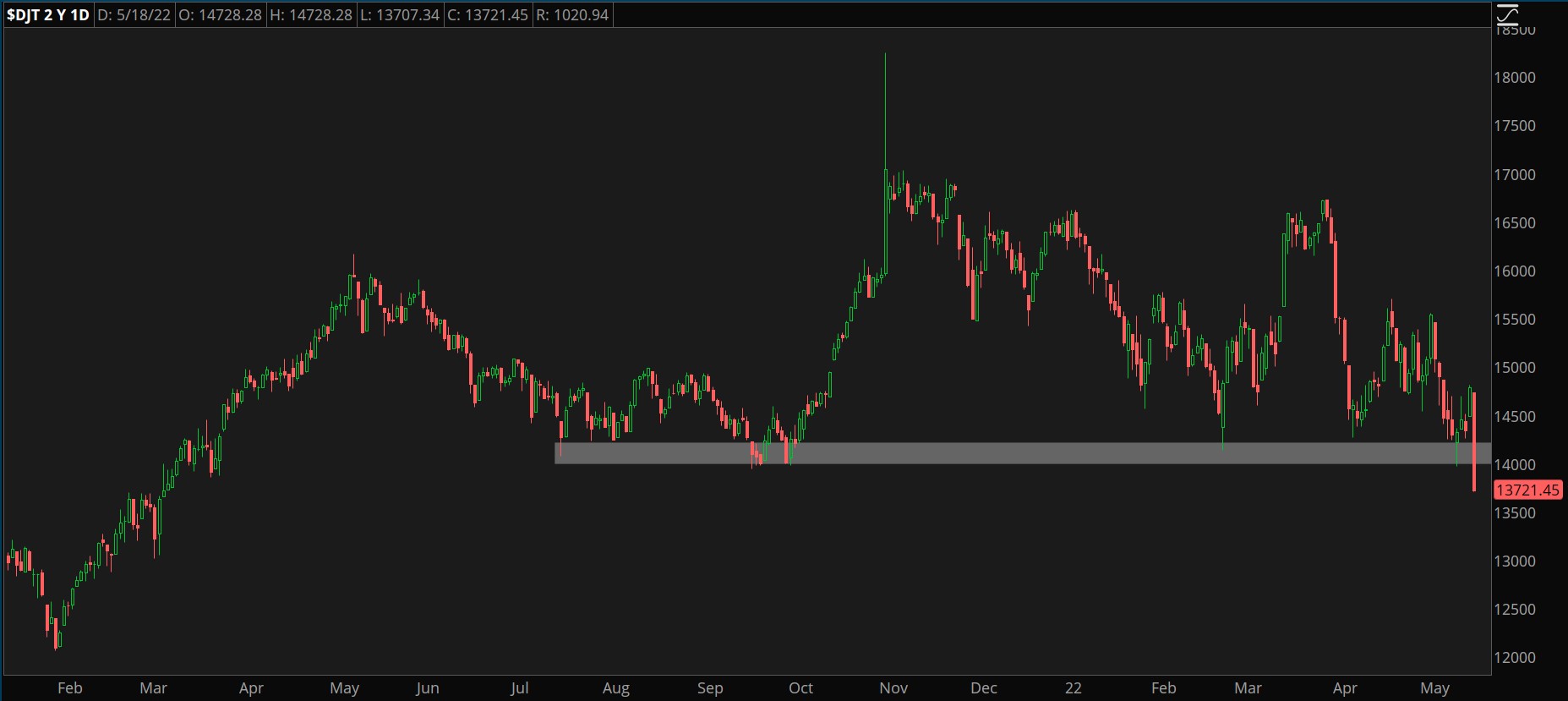Image sourced from Unsplash
This post contains sponsored advertising content. This content is for informational purposes only and not intended to be investing advice.
Wednesday Market Close) Stocks fell hard on Wednesday as earnings from large retailers including Target TGT and Walmart WMT missed due to inflation. Target plunged 24.93% in reaction to its earnings announcement Wednesday while Walmart has now fallen nearly 18% since releasing results on Monday. These two companies at the top of the retail business appeared to be caught off guard by their results and didn’t forecast improvement anytime soon.
Other retailers plunged on the news, leading the Dow Jones U.S. Retail Index down 7.69% on the day. Within that group were Amazon AMZN losing 7.16% and Kroger KR, falling 6.5%. Deep-discount stores with the smallest of profit margins also felt the pain as Dollar Tree DLTR tumbled 14.42% and Five Below FIVE slid 11.54%.
Fresh housing data showed the Fed’s rate strategy is taking a toll on the housing market. Building permits fell 3.2% in April and housing starts fell 0.2%. Additionally, mortgage applications fell 11% in the last week. The PHLX Housing Sector Index fell 4.64%.
The market selloff was broad and severe, sending the Dow Jones Industrial Average ($DJI) down 1,164 points for a daily loss of 3.57%, while the Nasdaq Composite ($COMP) plunged 4.72% while the S&P 500 (SPX) plummeted 4.4%. The S&P 500 closed below 4,000 and may not see support until the 3,700 level. The Cboe Market Volatility Index (VIX) spiked back above 31 as investor fears over inflation and profit margins rose.
All sectors were lower on the day, but the Consumer Discretionary Select Sector Index and the Consumer Staples Select Sector Index were the weakest, falling 6.59% and 6.48% respectively. Consumer goods are getting pinched with rising inflation as producers are struggling to pass on higher input costs to consumers. While some are putting up record sales, the numbers were skewed by rising inflation because stores are selling few units. This is the scenario of stagflation where the economy is slow, but inflation is still high.
Selling wasn’t just in the stock market—commodities lost ground too. The WTI crude oil futures fell 2.5% and RBOB gasoline futures slid 6.58% despite the news that Finland and Sweden are taking steps to join NATO. Russian president Vladimir Putin warned the two countries against making the move and promised repercussions. However, oil and gasoline prices fell in trading though rising costs at the pump that could slow down the summer travel season. The Dow Jones U.S. Travel & Leisure Index fell 4.63% and is trading back below its late-2020 highs.
Investors fled to the safety of bonds, pushing prices higher and yields lower. The 10-year Treasury yield (TNX) fell 82 basis points to 2.886%.

CHART OF THE DAY: BROKEN DOWN. The Dow Jones Transportation Average ($DJI—candlesticks) broke through the entire range of support levels. Data Sources: ICE, S&P Dow Jones Indices. Chart source: The thinkorswim® platform. For illustrative purposes only. Past performance does not guarantee future results.
Dow Theory Warning Signal
Dow theorists are investors who follow the writings of Charles Dow, co-founder of the Dow Jones & Company and The Wall Street Journal. One tenet of Dow Theory is that transportation stocks are a signal of economic strength. If raw and finished materials are still being shipped, then the economy is strong. Transports are actually a broader but cruder measurement of the economy than gross domestic product (GDP) which focuses only on finished goods.
A bearish signal occurs when the Dow Jones Transportation Average ($DJT) and the Dow Jones Industrial Average ($DJI) both trended down in today’s trading. I’ll refer you to a Dow theorist for the subtleties and nuances on how to interpret the charts.
Meanwhile, another measure of the economy that is broader than GDP is gross output (GO). GO is actually released with GDP and measures total economic activity by tracking all production of new goods and services. This means that GO measures all stages of the economy including resources, production, distribution, and final output, known as GDP.
According to economist Mark Skousen PhD, declining GO tends to precede a recession. Unfortunately, GO only comes out on a quarterly basis, but the latest numbers have indicated slowing in the economy but not a recession—yet. GO numbers can bear out the stagflation picture of slowing economic growth and higher inflation.
Notable Calendar Items
May 19: Philadelphia Manufacturing Index, Existing home sales, and earnings from Salesforce CRM, Applied Materials AMAT, and Kohls KSS
May 20: Earnings from Deere & Co. DE and Foot Locker FL
May 23: Earnings from Advance Auto Parts AAP
May 24: New home sales and earnings from Intuit INTU, Best Buy BBY, Ralph Lauren RL, Toll Brothers TOL, and Nordstrom JWN
May 25: Durable goods, FOMC meeting minutes and earnings from NVIDIA NVDA, Splunk SPLK, Williams-Sonoma WSM, and Dick’s Sporting Goods DKS
TD Ameritrade® commentary for educational purposes only. Member SIPC.
This post contains sponsored advertising content. This content is for informational purposes only and not intended to be investing advice.
© 2025 Benzinga.com. Benzinga does not provide investment advice. All rights reserved.
Trade confidently with insights and alerts from analyst ratings, free reports and breaking news that affects the stocks you care about.